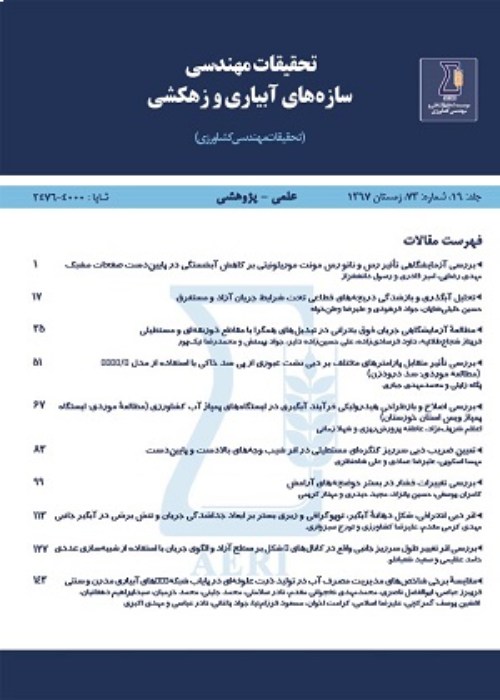Determining of the amount of water used, yield and water productivity in tomato fieldsin Razavi Khorasan province
Razavi Khorasan province is one of Khorasan provinces in northeastern Iran, centered on Mashhad. The area of this province is 118854 square kilometers. Due to having high evaporation potential and low rainfall, which is mostly associated with inappropriate distribution, this region is among the dry and semi-arid regions of our country, so that water is considered the most important factor limiting the growth and development of agriculture. Nowadays, the existence of limitations in water resources has made it necessary to create ways to increase water productivity. This is a proof of the importance of careful planning and finding the use of different irrigation methods to increase the water productivity of agricultural and garden crops. By examining the sources, it was found that the amount of water used in the tomato crop varies in different regions and with different irrigation systems. This research aims to measure the volume of applied water, the yield and productivity of tomato juice under the management of farmers in Razavi Khorasan province (Torbetjam, Chenaran and Mashhad cities) and compare the amount of applied water with the water requirement of tomatoes in these three plains (city) with the national document and It was also calculated by Penman-Monteith method with meteorological data.
This project was carried out in the field in order to determine the useful water of tomatoes in the fields under the management of farmers during one cropping season (2019). Three cities of Torbat Jam, Chenaran and Mashhad were selected in Razavi Khorasan province, which have the largest area under tomato cultivation. At first, based on the data required by the project, a questionnaire containing necessary information for investigation and logical conclusion was prepared. The required data of the selected farms in each city were either measured or through face-to-face interviews with the farmer or were calculated and completed according to the data of the previous two stages. The measurements were carried out in type of water source, irrigation network and method and water source discharge, total level The field and area under cultivation of tomato crop, variety, planting arrangement, planting date, soil texture, electrical conductivity of irrigation water and soil saturation extract, date of first irrigation, irrigation cycle and different irrigation methods, etc. The Measured Applied water were compared with the net irrigation water requirement estimated by the Penman-Monteith method using the last 10 years meteorological data (2010 to 2019) and also with the national water document values. Crop yield was recorded at the end of the growing season and water productivity was calculated as the ratio of yield to total water (irrigation applied water and effective rainfall).
The results showed that the amount of applied water, the amount of tomato yield and the water productivity in Torbat Jam region were 13424 m3/ha, 50629 kg/ha and 3.825 kg/m3, respectively. The amount of applied water, the amount of tomato yield and the water productivity in Chenaran region were determined as 10782 m3/ha, 67700 kg/ha and 6.266 kg/m3, respectively and The amount of applied water, the amount of tomato yield and the water productivity in Mashhad region were determined as 12262 m3/ha, 63686 kg/ha and 4.410 kg/m3, respectively. The average amount of applied water, the amount of tomato yield and the water productivity in above three regions were determined as 12245 m3/ha, 60219 kg/ha and 5.096 kg/m3, respectively. Also, the average volume of irrigation water, yield and productivity of water in the surface irrigation method were 13379 m3/ha, 52682 kg/ha and 4.042 kg/m3respectively, and in the drip irrigation method are 11621 m3/ha 64365 kg/ha and 5.656 kg/m3 was obtained.
In Razavi Khorasan province, underground water sources are facing a reservoir deficit. Therefore, efforts towards better use of extracted water and reducing exploitation of underground water resources are inevitable. In this project, the water given by the farmers for tomato production during one cropping season and without expert intervention in the irrigation management of the farmer was measured in the three plains of Torbat Jam, Chenaran and Mashhad, which had the largest area under tomato cultivation in Razavi Khorasan province. The method of irrigation of the fields was surface and drip irrigation (type). The results showed that the average applied water, yield and water productivity in all investigated tomato fields were 12245 cubic meters per hectare, 60219 kg per hectare and 5.096 kg per cubic meter of water, respectively. The difference between the volume of applied water, performance and water efficiency in two methods of surface and drip irrigation was significant. Under the drip irrigation system, the amount of applied water is 15% less (11,621 cubic meters per hectare versus 13,379), the yield is 22% higher (64,365 kg/hectare versus 52,682) and the water efficiency is about 40% higher (5.676 kg/cubic meter in vs. 4/042) was from the surface irrigation method.
- حق عضویت دریافتی صرف حمایت از نشریات عضو و نگهداری، تکمیل و توسعه مگیران میشود.
- پرداخت حق اشتراک و دانلود مقالات اجازه بازنشر آن در سایر رسانههای چاپی و دیجیتال را به کاربر نمیدهد.


